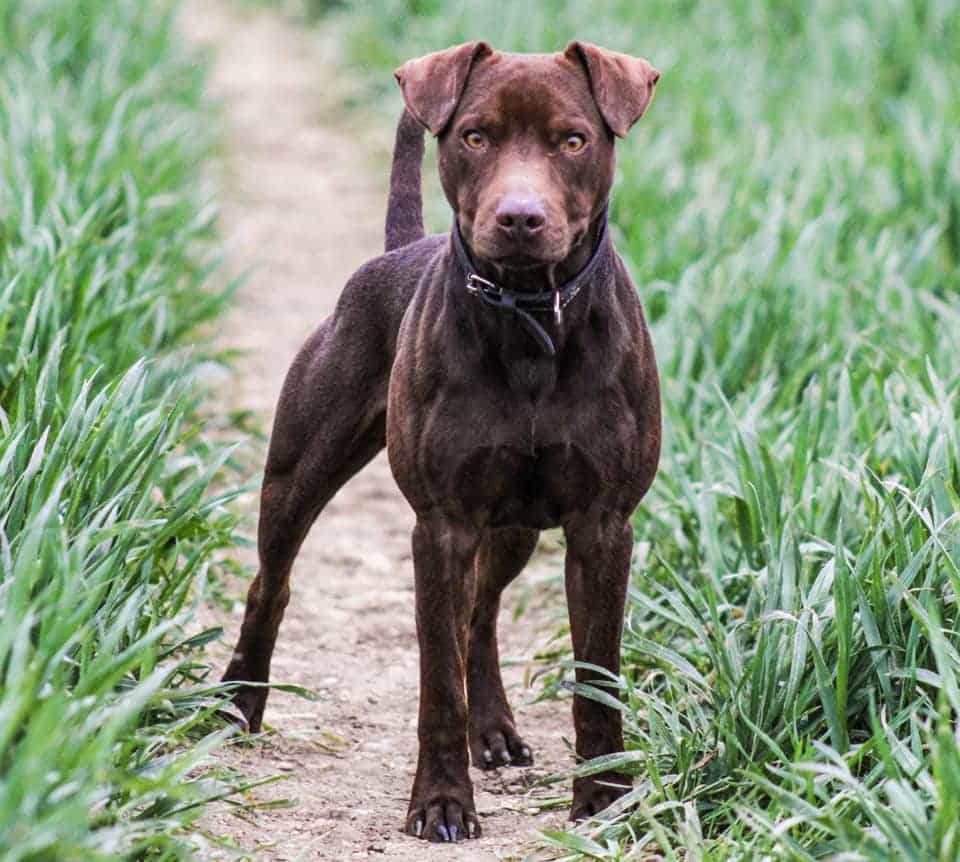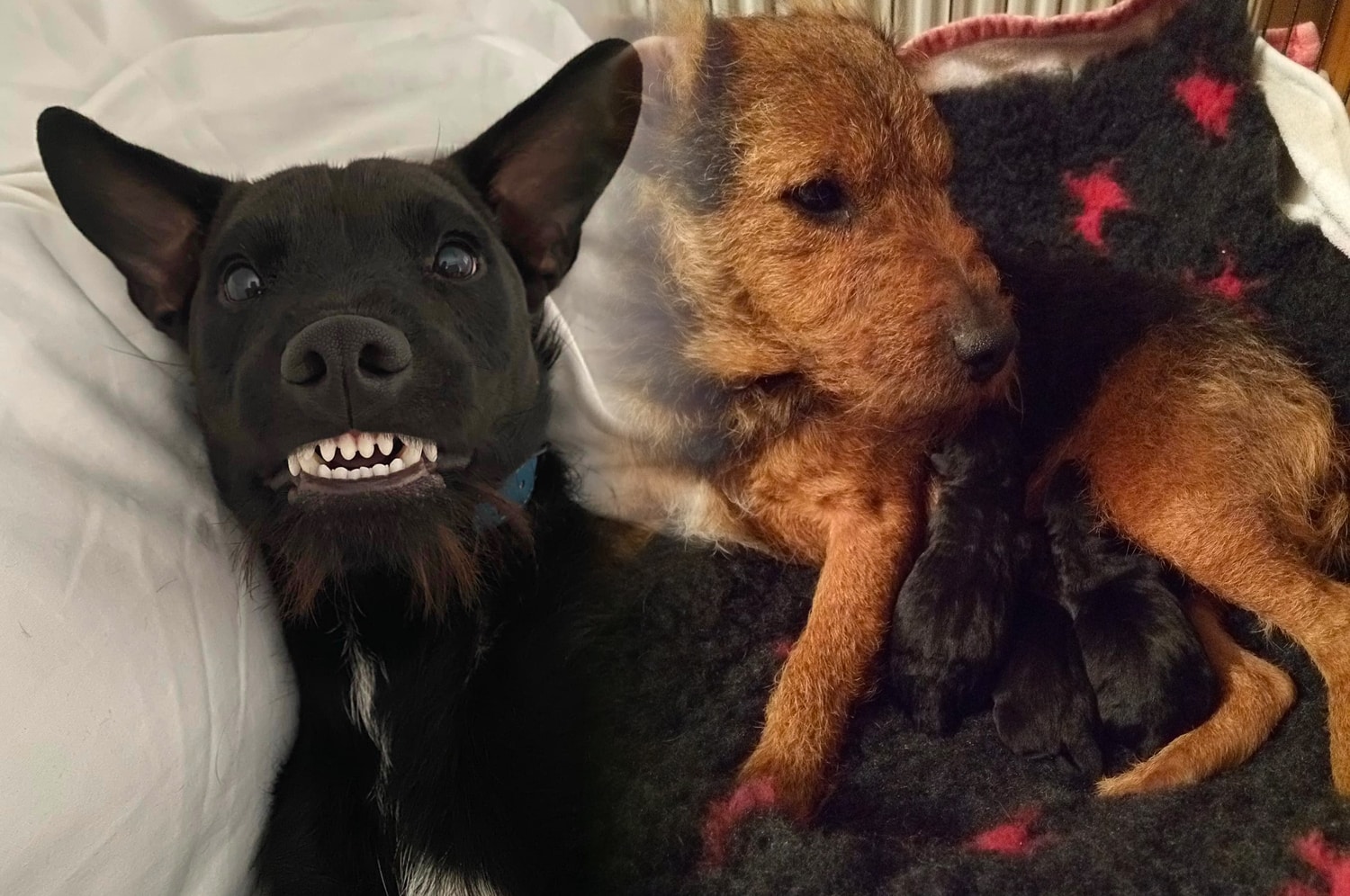Table of Contents
A Patterdale Lakeland Cross, also known as a Patterland Terrier, is – you guessed it, a cross between a Patterdale Terrier and a Lakeland Terrier!
As expected, the resulting Patterland has all the expected features of the Terrier family; extremely fast, with high energy levels, a tendency to chase anything that moves and a stubborn streak that can be difficult to workaround.
Overall the Patterland Terrier is an all-around brilliant dog – a faithful companion, tough yet loving and plenty of fun.
What are crossbreeds?
Crossbreeds are the offspring produced by the act of breeding two different dog breeds with one another.
In this case, a Patterdale Terrier with a Lakeland Terrier.
Crossbreeding is a rather highly debated topic in dog breeder circles; however, it has been practised for centuries. Even so, some breeders view crossbreeds as ‘impure’ or ‘mutts’ while others consider the act of crossbreeding as simply getting the best of both worlds!
By breeding two different species together, you can fulfil a need for a particular skill, look or property that a specific breed lacks. For example, the Cockapoo and Labradoodle were initially bred to meet a demand for hypoallergenic pets that wouldn’t trigger allergies.
Some of the most popular crossbreeds in the world at present include:
- Cockapoo – A cross between a Cocker Spaniel and a Poodle
- Sprocker Spaniel – A cross between a Springer Spaniel and a Cocker Spaniel
- Labradoodle – A cross between a Labrador and a Poodle
- Goldendoodle – A cross between a Golden Retriever and a Poodle
- Puggle – A cross between a Pug and a Beagle
- Jackapoo – A cross between a Jack Russell Terrier and a Poodle
- Chorkie – A cross between a Chihuahua and a Yorkshire Terrier
Lakeland Terrier
Lakeland Terriers were originally bred in the Lake District in England, which is where their name comes from. They were bred for the hunting of foxes by farmers who were fed up with their sheep herds being eaten.

Lakelands are terriers through and through – working dogs, with high energy levels, great physicality and a stubborn nature all wrapped up in a lovable and loyal companion.
Cost of a Lakeland Terrier
The cost of a purebred Lakeland Terrier puppy is, on average, between £800-1,000.
The price of Lakelands is surprisingly high, especially compared to other terrier breeds. The higher than average cost may stem from the fact that they are a lesser-known breed that can be much harder to find than other terriers.
You may be able to find an adult Lakeland for a few hundred pounds cheaper than a puppy if this is something you’re after.
It’s important to remember that the price of a dog is often influenced by the reasons the owner gives them up; if the price of a dog seems too good to be true, it usually is.
Lakeland Terrier Colours
When they are first born, Lakeland puppies appear rather dark in colour. However, they come in many colours, including:
- Black
- Blue
- Red
- Liver (a deep warm brown with a hint of red)
- Wheaten (light golden, fawn shade)
Typically, Lakies have a ‘saddle’, which means the fur along their back is darker. The darker fur gives the appearance of a saddle on the dog’s back.
Coat type of a Lakeland Terrier
Thanks to their history in the wet and cold Lake District, Lakeland Terriers have not one but two coats! A thick, hard topcoat to protect them from thorns and a soft, fluffy undercoat to keep them toasty in harsh conditions.
The coat type of a Lakeland Terrier is often described as short to medium in length and is incredibly dense. The texture of a Lakie’s fur is best defined as wiry; however, they tend to have longer, fluffier fur around their face and the bottom of their legs.
Because of the short length and density of their coat, Lakeland Terriers don’t really shed their fur often – a positive for anyone who hates constantly hoovering up after their dog!
Grooming a Lakeland Terrier
Traditional, working Lakeland owners recommend hand stripping their coats instead of clipping them. Stripping is a traditional technique that involves plucking the dead hair by hand, allowing the new hair to grow through in its place.
This technique isn’t used as much today – you may even struggle to find a groomer who offers this service, as some believe it is cruel for the dog.
You can clip a Lakeland Terrier’s coat, of course. It won’t cause any damage, but it can lead to the texture and colour of your Lakie’s coat becoming softer and lighter over time.
In general, Lakeland Terriers don’t require baths too frequently – unless you’ve taken them on a particularly muddy walk, of course. A bath every 4-6 weeks is ideal, but brushing should be more frequent. Try to brush your Lakie’s coat at least once a week to encourage growth and healthy turnover.
Patterdale Terrier
The Patterdale Terrier also originally stems from the Lake District, getting their name from Patterdale in Cumbria. The Patterdale is a working breed made for hunting foxes and rodents.

Although not officially recognised by kennel clubs, the Patterdale is a Northern Terrier to the core; highly intelligent and energetic with a strong prey drive and a stubbornness that will drive you mad.
Cost of a Patterdale Terrier
On average, the price of a Patterdale Terrier puppy ranges from £500-£800, coming in at a slightly more affordable price than the Lakeland Terrier. The lower cost of Patterdales is often attributed to the fact kennel clubs do not recognise them.
Like Lakelands, you can often find an adult Patterdale on the market for much cheaper, depending on the circumstances for the current owner to give them up.
Patterdale Terrier Colours
Whenever you see a Patterdale, it will most likely be a dark colour. However, they do come in a few different shades, including:
- Black
- Chocolate
Coat type of a Patterdale Terrier
Patterdales come in three different coat types, smooth, rough and broken.
You may see some Patterdale Terriers with what is often referred to as a ‘broken’ coat. A broken coat is a term given to the extra, feathery pieces of fur some dogs get around their face that exaggerates their eyebrows and forms a beard.
Grooming a Patterdale Terrier
Due to their usually short fur, Patterdale Terriers are fairly low maintenance dogs. Therefore, they don’t require brushing as regularly as a Lakeland, maybe once a fortnight if you can.
The same goes for bathing; unless your Patterdale is incredibly dirty from a game in the mud, a bath every 10-12 weeks is sufficient.
Plus, being such an active breed, they will naturally wear down their nails, leaving you one less job to do.
Patterdale Cross Lakeland
Now you’ve got a better idea of the two breeds that make up this crossbreed, let’s take a look at the Patterland.

Patterland Appearance
As both Patterdale Terriers and Lakeland Terriers come in a wide range of colours, so do their offspring. Patterlands commonly tend to be dark in appearance; however, they do come in a wide range of colours, including:
- Black
- Brown
- Liver
- Blue
- Wheaten
- Pied
The distinctive saddle pattern of a Lakeland sometimes shows through in the crossbreed, but it’s relatively rare.
The wiry coat of the Lakeland is usually dominated by the straight coat of the Patterdale, with Patterlands almost always having straight coats. Sometimes the mixture of the two can result in a slightly wavy coat, but it’s usually uncommon to see a wiry Patterland.
While the texture of the Lakeland Terriers fur is lost on the Patterland, the thickness of the coat is not; Patterdale Lakeland crossbreeds have a dense, often broken coat that requires regular brushing.
Temperament of a Patterdale Lakeland Cross
Patterlands definitely display the typical characteristics of a terrier breed. They are bold and mischievous dogs with plenty of energy and a stubborn ego.
Patterdales and Lakelands are working dog breeds with a strong prey drive. This, mixed with their high levels of intelligence, can be a demanding mix for first-time owners.
As a result, Patterlands require lots of physical and mental exercise.
Lack of stimulation can quickly turn to boredom, which unfortunately turns to destructive behaviour and aggression.
Overall, Patterlands are just as loving and loyal as their counterparts. Unfortunately, this can also lead to separation anxiety if left alone for too long. However, with proper training and enough stimulation, you’ll have a best friend for life!
Cost of a Patterland
With Lakeland Terriers being a pricier dog than a Patterdale Terrier, it’s rather surprising that the mix of the two is affordable. The average price of a Patterdale Lakeland Cross on the market is between £600-900.
While slightly more expensive than a purebred Patterdale, the crossbreed is cheaper than purchasing a purebred Lakeland Terrier. So if you were after a Lakeland, but they’re slightly out of your price range, then a Patterland is the perfect compromise.
Although it is a cliché, with a Patterland, you really do get the best of both worlds; a terrier through and through that will always be by your side – what more could you want.

